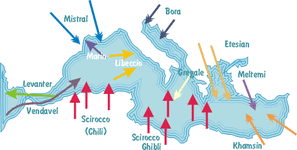Το κείμενό μου (σε περιβάλλον Κεντρικής Ευρώπης που πρέπει να μεταφέρω στα καθ' ημάς), εξηγεί:
Ακόμα και χωρίς πυξίδα, υπάρχουν στη φύση πολλά σημάδια που μπορούμε να χρησιμοποιήσουμε για να βρούμε τα σημεία του ορίζοντα. Επειδή ο άνεμος είναι συνήθως βορειοδυτικός, τα απομονωμένα δέντρα έχουν μια κλίση προς νοτιοανατολικά.
Έχω την αίσθηση ότι οι άνεμοι που επικρατούν στην Ελλάδα είναι συνήθως βορειοανατολικοί, αλλά μπορεί κάποιος, λιγότερο αστικοποιημένος από εμένα, να το επιβεβαιώσει;
ΤΙΑ
Ακόμα και χωρίς πυξίδα, υπάρχουν στη φύση πολλά σημάδια που μπορούμε να χρησιμοποιήσουμε για να βρούμε τα σημεία του ορίζοντα. Επειδή ο άνεμος είναι συνήθως βορειοδυτικός, τα απομονωμένα δέντρα έχουν μια κλίση προς νοτιοανατολικά.
Έχω την αίσθηση ότι οι άνεμοι που επικρατούν στην Ελλάδα είναι συνήθως βορειοανατολικοί, αλλά μπορεί κάποιος, λιγότερο αστικοποιημένος από εμένα, να το επιβεβαιώσει;
ΤΙΑ

